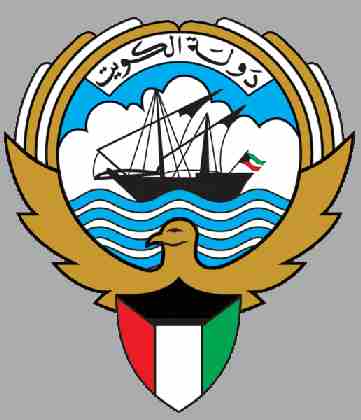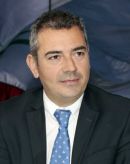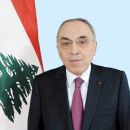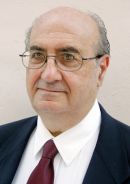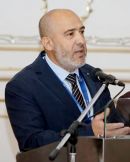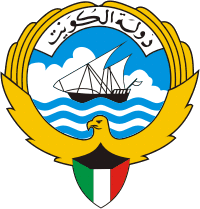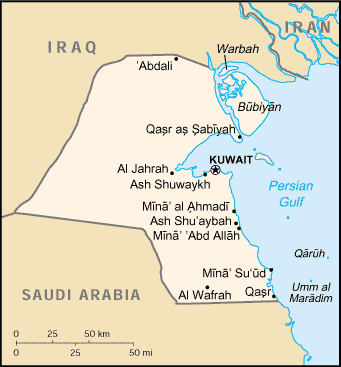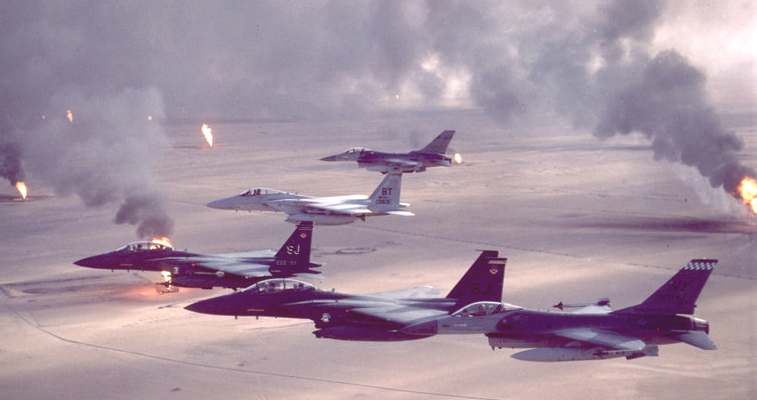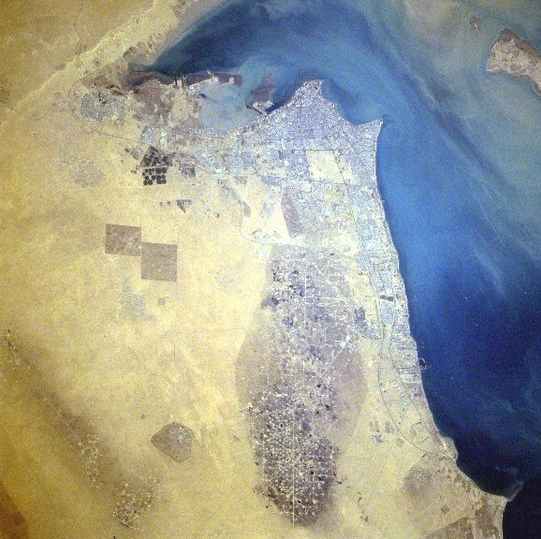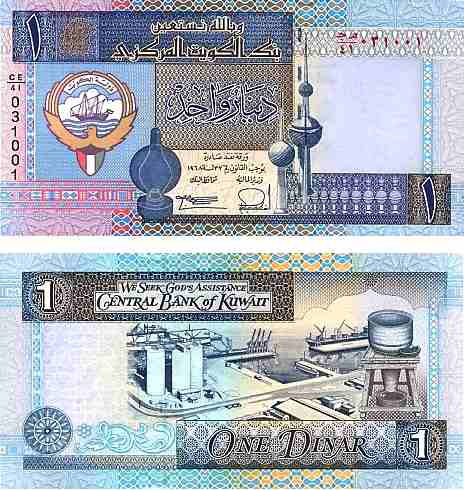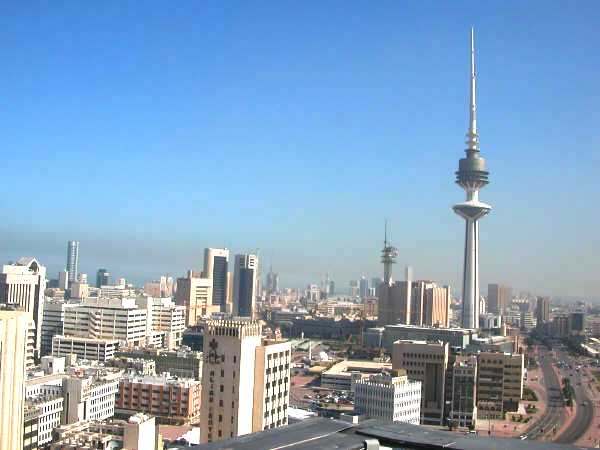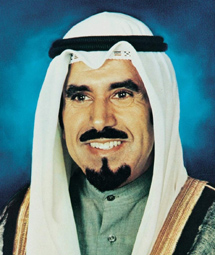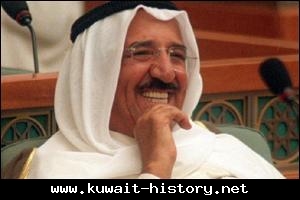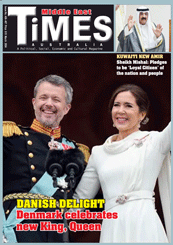 |
 |
 |
|
|
|
|||||||||||||||||||
|
||||||||||||||||||||
Modern Kuwait – The Jet Age 3 Kuwait International Airport is located in Farwaniyah, Kuwait, 15.5 kilometers south of Kuwait City. It is the hub of Jazeera Airways, Kuwait Airways, United Aviation, and Wataniya Airways. A portion of the airport complex is designated as Al Mubarak Air Base, which contains the headquarters of the Kuwait Air Force, as well as the Kuwait Air Force Museum. The airport underwent a massive renovation and expansion project from 1999-2001, in which a terminal expansion was built. This incorporated new check-in areas, a new entrance to the airport, the construction of a multi-story parking structure, and an airport mall. Kuwait International Airport can currently handle more than seven million passengers a year. A new general aviation terminal was completed in 2008 under a BOT scheme and is operated by Royal Aviation. By the end of 2008 this terminal was modified to handle the scheduled services of the new Wataniya Airways along with general aviation traffic. The terminal was renamed as Sheikh Saad Terminal. The Directorate General of Civil Aviation has announced that a new terminal will begin construction, and will increase the annual passenger handling amount to twenty million. Terminal 2, essentially an extension of Terminal 1, is due for completion by 2014. Kuwait Airways The Kuwait Airways headquarters is located on the grounds of Kuwait International Airport. The 42,000 square metres head office was built for US $ 53.6 million. The headquarters, built in 48 months, was constructed from 1992 to 1996. The construction of the head office was the first time that structural glazing for curtain walls was used in the State of Kuwait. During the oil boom of the 1940s, a national carrier was born in 1954. Initially, Kuwait Airways Company served a limited network of Abadan, Beirut, Damascus and Jerusalem but a year later the carrier was facing economic hardship, and the government of Kuwait took a 50% interest in the airline, subsequently doubling the company's capital, shortly after the government finally took out 100% share in Kuwait Airways. Kuwait Airways entered the jet age in 1962 by leasing a Comet 4-C, the world's first jet-engined airliner. In 1978, Kuwait Airways entered the wide-body age by taking delivery of its first two B747-200s, adding a third the following year. This expansion permitted Kuwait Airways to extend its network to New York to the west and Manila to the east. Modernization of the fleet continued, and four Boeing 727 were delivered in 1980-1981. Two years later eight Airbus A310 and Airbus A300-600 were delivered, and in 1986 three Boeing 767-200ER aircraft joined the wide-body fleet. Following the destruction of its premises and 42 of its aircraft during the Iraqi invasion of Kuwait, the airline was relaunched. Kuwait Airways fleet now comprises four A320-200, three A310-300, five A300-605R, five A340-300 and two Boeing 777-200ER, bringing the fleet to 20 aircraft. Kuwait Airways aims to reach more than 47 countries around the globe with a firm commitment to providing the finest service and comfort to passengers while continuing to rank safety as one of highest priorities. Kuwait Investment Authority (KIA) has formed the foundation committee for the privatization of Kuwait Airways Corporation (KAC), the foundation committee started the work immediately after signing the decision, noting that transferring the assets of KAC and its subsidiaries to KIA will take more than four months, thereby KAC will officially become a shareholding company. As of September 2009, Kuwait Airways flies to 44 international destinations in 28 countries across Africa, Asia, Europe and North America from its hub at Kuwait International Airport.
*****
Modern Kuwait 2 Kuwait City is the capital of Kuwait. Although it goes back a long time in history, the present day city is very modern. Kuwait City is a bustling metropolis of high-rise office buildings, luxury hotels, wide boulevards, parks and gardens. Kuwait is a constitutional monarchy with a parliamentary system of government, with Kuwait City serving as the country's political and economic capital. The country has the world's fifth largest oil reserves and petroleum products now account for nearly 95% of export revenues, and 80% of government income. Kuwait is the eleventh richest country in the world per capita and has the highest human development index (HDI) in the Arab world. Kuwait is classified as a high income economy by the World Bank and is designated as a major non-NATO ally of the United States. Culture The influence of Islamic and Arab culture on its architecture, music, attire, cuisine and lifestyle is prominent as well. The most distinctive characteristic of local Kuwaiti culture are dewaniya that is explained below. Briefly, it involves large reception rooms used for male social gatherings attended mostly by family members and close friends. While, unlike neighboring Saudi Arabia, the Islamic dress code is not compulsory, many of the older Kuwaiti men prefer wearing dish dasha, an ankle-length white shirt woven from wool or cotton while the minority of women wear abaya, black over-garment covering most parts of the body. This attire is particularly well-suited for Kuwait's hot and dry climate. Western-style clothing is also fairly popular, especially among Kuwait's youth. Seafood has been the main Kuwaiti diet for centuries. The Arabs in the Persian Gulf region played a crucial role in the spice trade between India and Europe and spices have remained an important ingredient of Kuwaiti cuisine. Traditional Kuwaiti cuisine includes "Machboos diyay, machboos laham, maraq diyay laham" which borrows heavily from South Asian cuisine and Persian cuisine. As in other Persian Gulf states, Kuwait takes part in the tradition of Qarqe'an during the month of Ramadan. Before the discovery of oil, pearling formed a crucial part of Kuwait's economy. Pearl fishery, known as ghaus, suffered decline after the advent of Japanese pearl farming. However, Kuwait's pearl industry laid the foundation of its rich maritime history. Dhows, large wooden ships made from teak wood imported from India, became an indistinct part of Kuwait's maritime fleet and dhow building is still practiced in this Persian Gulf state. Kuwait's architecture is largely inspired by Islamic architecture. The most prominent landmark in country, the Kuwait Towers, were designed by Swedish architect Sune Lindström and are a unique blend of traditional minaret and modern architectural designs. The National Assembly of Kuwait, another famous landmark building, was designed by the famous Danish architect Jørn Utzon and completed in 1972. Sawt is the most prominent style of Kuwaiti music and is performed by 'ud/oud (plucked lute) and mirwas (a drum), with a violin later supplementing the arrangement. The Bedouins are known for an instrument called the rubabah, while the use of oud, tanbarah (string instrument) and habban (bagpipe) are also widespread.
*****
Kuwait Liberation Day 1
Every year Kuwait celebrates its Liberation Day on the 26th of February. This official public holiday is celebrated in honour of the country’s independence from Iraq after the first Gulf War. Liberation Day celebrates the liberation of Kuwait by a multi-national force from seven months of traumatic Iraqi occupation on February 26, 1991. Each year the day is marked with public gatherings.
National Day celebrates on the 25th February independence of Kuwait from Britain in 1961 and the reign of Sheikh Abdullah Al Salim Al Sabah, the Emir who guided Kuwait during this transformation and who earned the moniker “Father of the Constitution.” Abdullah’s reign was so central to the evolution of modern Kuwait that when he died in 1965, the date on which he had ascended the throne in 1950 (February 25) was designated National Day. Previously, Kuwaitis had celebrated their national holiday on the date of the dissolution of the Anglo-Kuwaiti agreement.
Kuwait is believed to have been part of an early civilization in the 3rd millennium B.C. and to have traded with Mesopotamian cities. The area that is now Kuwait was largely uninhabited up until the 18th century although archeologists have found indications of settlements as far back as 4500 BC. Archeological and historical traces disappeared around the first millennium B.C.
At the beginning of the 18th century, the Anizah tribe of central Arabia founded Kuwait City, which became an autonomous sheikdom by 1756. Abd Rahim of the al-Sabah became the first sheik, and his descendants continue to rule Kuwait today. In the late 18th and early 19th centuries, the sheikdom belonged to the fringes of the Ottoman Empire. The same families of Sheiks have ruled Kuwait since the 1750s, when Kuwait’s location on the Persian Gulf made it a thriving port.
Kuwait obtained British protection in 1897 when the sheik feared that the Turks would expand their hold over the area. Kuwait enjoyed the ambiguous status of a “caza,” an autonomous city by the Ottoman Empire, but in 1899 it began a relationship with Britain, sacrificing some autonomy in return for British naval protection. Britain wanted to secure access through the Gulf, a major transit point between England and India and to block Germany and its Ottoman allies.
In the 1930s the discovery of oil changed the country. At that time pearl-diving was a leading occupation for Kuwaitis; two decades later the small nation would be one of the largest oil exporters in the world.
In 1961, Britain ended the protectorate, giving Kuwait independence, but agreed to give military aid on request. Kuwait gained independence from Britain on June 19, 1961, and Kuwait became the first country in the Gulf region to adopt a Constitution and parliament. Iraq immediately threatened to occupy the area, and the British sent troops to defend Kuwait.
Soon afterward, the Arab League sent in troops, replacing the British. Iraq's claim was dropped when the Arab League recognized Kuwait's independence on July 20, 1961. Historically Kuwait followed a neutral and mediatory policy among Arab states.
*****
The airport underwent a massive renovation and expansion project from 1999-2001, in which a terminal expansion was built. This incorporated new check-in areas, a new entrance to the airport, the construction of a multi-story parking structure, and an airport mall. Kuwait International Airport can currently handle more than seven million passengers a year. A new general aviation terminal was completed in 2008 under a BOT scheme and is operated by Royal Aviation. By the end of 2008 this terminal was modified to handle the scheduled services of the new Wataniya Airways along with general aviation traffic. The terminal was renamed as Sheikh Saad Terminal. The Directorate General of Civil Aviation has announced that a new terminal will begin construction, and will increase the annual passenger handling amount to twenty million. Terminal 2, essentially an extension of Terminal 1, is due for completion by 2014. Kuwait Airways The Kuwait Airways headquarters is located on the grounds of Kuwait International Airport. The 42,000 square metres head office was built for US $ 53.6 million. The headquarters, built in 48 months, was constructed from 1992 to 1996. The construction of the head office was the first time that structural glazing for curtain walls was used in the State of Kuwait. During the oil boom of the 1940s, a national carrier was born in 1954. Initially, Kuwait Airways Company served a limited network of Abadan, Beirut, Damascus and Jerusalem but a year later the carrier was facing economic hardship, and the government of Kuwait took a 50% interest in the airline, subsequently doubling the company's capital, shortly after the government finally took out 100% share in Kuwait Airways. Kuwait Airways entered the jet age in 1962 by leasing a Comet 4-C, the world's first jet-engined airliner. In 1978, Kuwait Airways entered the wide-body age by taking delivery of its first two B747-200s, adding a third the following year. This expansion permitted Kuwait Airways to extend its network to New York to the west and Manila to the east. Modernization of the fleet continued, and four Boeing 727 were delivered in 1980-1981. Two years later eight Airbus A310 and Airbus A300-600 were delivered, and in 1986 three Boeing 767-200ER aircraft joined the wide-body fleet. Following the destruction of its premises and 42 of its aircraft during the Iraqi invasion of Kuwait, the airline was relaunched. Kuwait Airways fleet now comprises four A320-200, three A310-300, five A300-605R, five A340-300 and two Boeing 777-200ER, bringing the fleet to 20 aircraft. Kuwait Airways aims to reach more than 47 countries around the globe with a firm commitment to providing the finest service and comfort to passengers while continuing to rank safety as one of highest priorities. Kuwait Investment Authority (KIA) has formed the foundation committee for the privatization of Kuwait Airways Corporation (KAC), the foundation committee started the work immediately after signing the decision, noting that transferring the assets of KAC and its subsidiaries to KIA will take more than four months, thereby KAC will officially become a shareholding company. As of September 2009, Kuwait Airways flies to 44 international destinations in 28 countries across Africa, Asia, Europe and North America from its hub at Kuwait International Airport.
*****
Modern Kuwait 2 Kuwait City is the capital of Kuwait. Although it goes back a long time in history, the present day city is very modern. Kuwait City is a bustling metropolis of high-rise office buildings, luxury hotels, wide boulevards, parks and gardens. Kuwait is a constitutional monarchy with a parliamentary system of government, with Kuwait City serving as the country's political and economic capital. The country has the world's fifth largest oil reserves and petroleum products now account for nearly 95% of export revenues, and 80% of government income. Kuwait is the eleventh richest country in the world per capita and has the highest human development index (HDI) in the Arab world. Kuwait is classified as a high income economy by the World Bank and is designated as a major non-NATO ally of the United States. Culture The influence of Islamic and Arab culture on its architecture, music, attire, cuisine and lifestyle is prominent as well. The most distinctive characteristic of local Kuwaiti culture are dewaniya that is explained below. Briefly, it involves large reception rooms used for male social gatherings attended mostly by family members and close friends. While, unlike neighboring Saudi Arabia, the Islamic dress code is not compulsory, many of the older Kuwaiti men prefer wearing dish dasha, an ankle-length white shirt woven from wool or cotton while the minority of women wear abaya, black over-garment covering most parts of the body. This attire is particularly well-suited for Kuwait's hot and dry climate. Western-style clothing is also fairly popular, especially among Kuwait's youth. Seafood has been the main Kuwaiti diet for centuries. The Arabs in the Persian Gulf region played a crucial role in the spice trade between India and Europe and spices have remained an important ingredient of Kuwaiti cuisine. Traditional Kuwaiti cuisine includes "Machboos diyay, machboos laham, maraq diyay laham" which borrows heavily from South Asian cuisine and Persian cuisine. As in other Persian Gulf states, Kuwait takes part in the tradition of Qarqe'an during the month of Ramadan. Before the discovery of oil, pearling formed a crucial part of Kuwait's economy. Pearl fishery, known as ghaus, suffered decline after the advent of Japanese pearl farming. However, Kuwait's pearl industry laid the foundation of its rich maritime history. Dhows, large wooden ships made from teak wood imported from India, became an indistinct part of Kuwait's maritime fleet and dhow building is still practiced in this Persian Gulf state. Kuwait's architecture is largely inspired by Islamic architecture. The most prominent landmark in country, the Kuwait Towers, were designed by Swedish architect Sune Lindström and are a unique blend of traditional minaret and modern architectural designs. The National Assembly of Kuwait, another famous landmark building, was designed by the famous Danish architect Jørn Utzon and completed in 1972. Sawt is the most prominent style of Kuwaiti music and is performed by 'ud/oud (plucked lute) and mirwas (a drum), with a violin later supplementing the arrangement. The Bedouins are known for an instrument called the rubabah, while the use of oud, tanbarah (string instrument) and habban (bagpipe) are also widespread.
*****
Kuwait Liberation Day 1
Every year Kuwait celebrates its Liberation Day on the 26th of February. This official public holiday is celebrated in honour of the country’s independence from Iraq after the first Gulf War. Liberation Day celebrates the liberation of Kuwait by a multi-national force from seven months of traumatic Iraqi occupation on February 26, 1991. Each year the day is marked with public gatherings.
National Day celebrates on the 25th February independence of Kuwait from Britain in 1961 and the reign of Sheikh Abdullah Al Salim Al Sabah, the Emir who guided Kuwait during this transformation and who earned the moniker “Father of the Constitution.” Abdullah’s reign was so central to the evolution of modern Kuwait that when he died in 1965, the date on which he had ascended the throne in 1950 (February 25) was designated National Day. Previously, Kuwaitis had celebrated their national holiday on the date of the dissolution of the Anglo-Kuwaiti agreement.
Kuwait is believed to have been part of an early civilization in the 3rd millennium B.C. and to have traded with Mesopotamian cities. The area that is now Kuwait was largely uninhabited up until the 18th century although archeologists have found indications of settlements as far back as 4500 BC. Archeological and historical traces disappeared around the first millennium B.C.
At the beginning of the 18th century, the Anizah tribe of central Arabia founded Kuwait City, which became an autonomous sheikdom by 1756. Abd Rahim of the al-Sabah became the first sheik, and his descendants continue to rule Kuwait today. In the late 18th and early 19th centuries, the sheikdom belonged to the fringes of the Ottoman Empire. The same families of Sheiks have ruled Kuwait since the 1750s, when Kuwait’s location on the Persian Gulf made it a thriving port.
Kuwait obtained British protection in 1897 when the sheik feared that the Turks would expand their hold over the area. Kuwait enjoyed the ambiguous status of a “caza,” an autonomous city by the Ottoman Empire, but in 1899 it began a relationship with Britain, sacrificing some autonomy in return for British naval protection. Britain wanted to secure access through the Gulf, a major transit point between England and India and to block Germany and its Ottoman allies.
In the 1930s the discovery of oil changed the country. At that time pearl-diving was a leading occupation for Kuwaitis; two decades later the small nation would be one of the largest oil exporters in the world.
In 1961, Britain ended the protectorate, giving Kuwait independence, but agreed to give military aid on request. Kuwait gained independence from Britain on June 19, 1961, and Kuwait became the first country in the Gulf region to adopt a Constitution and parliament. Iraq immediately threatened to occupy the area, and the British sent troops to defend Kuwait.
Soon afterward, the Arab League sent in troops, replacing the British. Iraq's claim was dropped when the Arab League recognized Kuwait's independence on July 20, 1961. Historically Kuwait followed a neutral and mediatory policy among Arab states.
*****
Kuwait Airways The Kuwait Airways headquarters is located on the grounds of Kuwait International Airport. The 42,000 square metres head office was built for US $ 53.6 million. The headquarters, built in 48 months, was constructed from 1992 to 1996. The construction of the head office was the first time that structural glazing for curtain walls was used in the State of Kuwait. During the oil boom of the 1940s, a national carrier was born in 1954. Initially, Kuwait Airways Company served a limited network of Abadan, Beirut, Damascus and Jerusalem but a year later the carrier was facing economic hardship, and the government of Kuwait took a 50% interest in the airline, subsequently doubling the company's capital, shortly after the government finally took out 100% share in Kuwait Airways. Kuwait Airways entered the jet age in 1962 by leasing a Comet 4-C, the world's first jet-engined airliner. In 1978, Kuwait Airways entered the wide-body age by taking delivery of its first two B747-200s, adding a third the following year. This expansion permitted Kuwait Airways to extend its network to New York to the west and Manila to the east. Modernization of the fleet continued, and four Boeing 727 were delivered in 1980-1981. Two years later eight Airbus A310 and Airbus A300-600 were delivered, and in 1986 three Boeing 767-200ER aircraft joined the wide-body fleet. Following the destruction of its premises and 42 of its aircraft during the Iraqi invasion of Kuwait, the airline was relaunched. Kuwait Airways fleet now comprises four A320-200, three A310-300, five A300-605R, five A340-300 and two Boeing 777-200ER, bringing the fleet to 20 aircraft. Kuwait Airways aims to reach more than 47 countries around the globe with a firm commitment to providing the finest service and comfort to passengers while continuing to rank safety as one of highest priorities. Kuwait Investment Authority (KIA) has formed the foundation committee for the privatization of Kuwait Airways Corporation (KAC), the foundation committee started the work immediately after signing the decision, noting that transferring the assets of KAC and its subsidiaries to KIA will take more than four months, thereby KAC will officially become a shareholding company. As of September 2009, Kuwait Airways flies to 44 international destinations in 28 countries across Africa, Asia, Europe and North America from its hub at Kuwait International Airport.
*****
Modern Kuwait 2 Kuwait City is the capital of Kuwait. Although it goes back a long time in history, the present day city is very modern. Kuwait City is a bustling metropolis of high-rise office buildings, luxury hotels, wide boulevards, parks and gardens. Kuwait is a constitutional monarchy with a parliamentary system of government, with Kuwait City serving as the country's political and economic capital. The country has the world's fifth largest oil reserves and petroleum products now account for nearly 95% of export revenues, and 80% of government income. Kuwait is the eleventh richest country in the world per capita and has the highest human development index (HDI) in the Arab world. Kuwait is classified as a high income economy by the World Bank and is designated as a major non-NATO ally of the United States. Culture The influence of Islamic and Arab culture on its architecture, music, attire, cuisine and lifestyle is prominent as well. The most distinctive characteristic of local Kuwaiti culture are dewaniya that is explained below. Briefly, it involves large reception rooms used for male social gatherings attended mostly by family members and close friends. While, unlike neighboring Saudi Arabia, the Islamic dress code is not compulsory, many of the older Kuwaiti men prefer wearing dish dasha, an ankle-length white shirt woven from wool or cotton while the minority of women wear abaya, black over-garment covering most parts of the body. This attire is particularly well-suited for Kuwait's hot and dry climate. Western-style clothing is also fairly popular, especially among Kuwait's youth. Seafood has been the main Kuwaiti diet for centuries. The Arabs in the Persian Gulf region played a crucial role in the spice trade between India and Europe and spices have remained an important ingredient of Kuwaiti cuisine. Traditional Kuwaiti cuisine includes "Machboos diyay, machboos laham, maraq diyay laham" which borrows heavily from South Asian cuisine and Persian cuisine. As in other Persian Gulf states, Kuwait takes part in the tradition of Qarqe'an during the month of Ramadan. Before the discovery of oil, pearling formed a crucial part of Kuwait's economy. Pearl fishery, known as ghaus, suffered decline after the advent of Japanese pearl farming. However, Kuwait's pearl industry laid the foundation of its rich maritime history. Dhows, large wooden ships made from teak wood imported from India, became an indistinct part of Kuwait's maritime fleet and dhow building is still practiced in this Persian Gulf state. Kuwait's architecture is largely inspired by Islamic architecture. The most prominent landmark in country, the Kuwait Towers, were designed by Swedish architect Sune Lindström and are a unique blend of traditional minaret and modern architectural designs. The National Assembly of Kuwait, another famous landmark building, was designed by the famous Danish architect Jørn Utzon and completed in 1972. Sawt is the most prominent style of Kuwaiti music and is performed by 'ud/oud (plucked lute) and mirwas (a drum), with a violin later supplementing the arrangement. The Bedouins are known for an instrument called the rubabah, while the use of oud, tanbarah (string instrument) and habban (bagpipe) are also widespread.
*****
Kuwait Liberation Day 1
Every year Kuwait celebrates its Liberation Day on the 26th of February. This official public holiday is celebrated in honour of the country’s independence from Iraq after the first Gulf War. Liberation Day celebrates the liberation of Kuwait by a multi-national force from seven months of traumatic Iraqi occupation on February 26, 1991. Each year the day is marked with public gatherings.
National Day celebrates on the 25th February independence of Kuwait from Britain in 1961 and the reign of Sheikh Abdullah Al Salim Al Sabah, the Emir who guided Kuwait during this transformation and who earned the moniker “Father of the Constitution.” Abdullah’s reign was so central to the evolution of modern Kuwait that when he died in 1965, the date on which he had ascended the throne in 1950 (February 25) was designated National Day. Previously, Kuwaitis had celebrated their national holiday on the date of the dissolution of the Anglo-Kuwaiti agreement.
Kuwait is believed to have been part of an early civilization in the 3rd millennium B.C. and to have traded with Mesopotamian cities. The area that is now Kuwait was largely uninhabited up until the 18th century although archeologists have found indications of settlements as far back as 4500 BC. Archeological and historical traces disappeared around the first millennium B.C.
At the beginning of the 18th century, the Anizah tribe of central Arabia founded Kuwait City, which became an autonomous sheikdom by 1756. Abd Rahim of the al-Sabah became the first sheik, and his descendants continue to rule Kuwait today. In the late 18th and early 19th centuries, the sheikdom belonged to the fringes of the Ottoman Empire. The same families of Sheiks have ruled Kuwait since the 1750s, when Kuwait’s location on the Persian Gulf made it a thriving port.
Kuwait obtained British protection in 1897 when the sheik feared that the Turks would expand their hold over the area. Kuwait enjoyed the ambiguous status of a “caza,” an autonomous city by the Ottoman Empire, but in 1899 it began a relationship with Britain, sacrificing some autonomy in return for British naval protection. Britain wanted to secure access through the Gulf, a major transit point between England and India and to block Germany and its Ottoman allies.
In the 1930s the discovery of oil changed the country. At that time pearl-diving was a leading occupation for Kuwaitis; two decades later the small nation would be one of the largest oil exporters in the world.
In 1961, Britain ended the protectorate, giving Kuwait independence, but agreed to give military aid on request. Kuwait gained independence from Britain on June 19, 1961, and Kuwait became the first country in the Gulf region to adopt a Constitution and parliament. Iraq immediately threatened to occupy the area, and the British sent troops to defend Kuwait.
Soon afterward, the Arab League sent in troops, replacing the British. Iraq's claim was dropped when the Arab League recognized Kuwait's independence on July 20, 1961. Historically Kuwait followed a neutral and mediatory policy among Arab states.
*****
During the oil boom of the 1940s, a national carrier was born in 1954. Initially, Kuwait Airways Company served a limited network of Abadan, Beirut, Damascus and Jerusalem but a year later the carrier was facing economic hardship, and the government of Kuwait took a 50% interest in the airline, subsequently doubling the company's capital, shortly after the government finally took out 100% share in Kuwait Airways. Kuwait Airways entered the jet age in 1962 by leasing a Comet 4-C, the world's first jet-engined airliner. In 1978, Kuwait Airways entered the wide-body age by taking delivery of its first two B747-200s, adding a third the following year. This expansion permitted Kuwait Airways to extend its network to New York to the west and Manila to the east. Modernization of the fleet continued, and four Boeing 727 were delivered in 1980-1981. Two years later eight Airbus A310 and Airbus A300-600 were delivered, and in 1986 three Boeing 767-200ER aircraft joined the wide-body fleet. Following the destruction of its premises and 42 of its aircraft during the Iraqi invasion of Kuwait, the airline was relaunched. Kuwait Airways fleet now comprises four A320-200, three A310-300, five A300-605R, five A340-300 and two Boeing 777-200ER, bringing the fleet to 20 aircraft. Kuwait Airways aims to reach more than 47 countries around the globe with a firm commitment to providing the finest service and comfort to passengers while continuing to rank safety as one of highest priorities. Kuwait Investment Authority (KIA) has formed the foundation committee for the privatization of Kuwait Airways Corporation (KAC), the foundation committee started the work immediately after signing the decision, noting that transferring the assets of KAC and its subsidiaries to KIA will take more than four months, thereby KAC will officially become a shareholding company. As of September 2009, Kuwait Airways flies to 44 international destinations in 28 countries across Africa, Asia, Europe and North America from its hub at Kuwait International Airport.
*****
Modern Kuwait 2 Kuwait City is the capital of Kuwait. Although it goes back a long time in history, the present day city is very modern. Kuwait City is a bustling metropolis of high-rise office buildings, luxury hotels, wide boulevards, parks and gardens. Kuwait is a constitutional monarchy with a parliamentary system of government, with Kuwait City serving as the country's political and economic capital. The country has the world's fifth largest oil reserves and petroleum products now account for nearly 95% of export revenues, and 80% of government income. Kuwait is the eleventh richest country in the world per capita and has the highest human development index (HDI) in the Arab world. Kuwait is classified as a high income economy by the World Bank and is designated as a major non-NATO ally of the United States. Culture The influence of Islamic and Arab culture on its architecture, music, attire, cuisine and lifestyle is prominent as well. The most distinctive characteristic of local Kuwaiti culture are dewaniya that is explained below. Briefly, it involves large reception rooms used for male social gatherings attended mostly by family members and close friends. While, unlike neighboring Saudi Arabia, the Islamic dress code is not compulsory, many of the older Kuwaiti men prefer wearing dish dasha, an ankle-length white shirt woven from wool or cotton while the minority of women wear abaya, black over-garment covering most parts of the body. This attire is particularly well-suited for Kuwait's hot and dry climate. Western-style clothing is also fairly popular, especially among Kuwait's youth. Seafood has been the main Kuwaiti diet for centuries. The Arabs in the Persian Gulf region played a crucial role in the spice trade between India and Europe and spices have remained an important ingredient of Kuwaiti cuisine. Traditional Kuwaiti cuisine includes "Machboos diyay, machboos laham, maraq diyay laham" which borrows heavily from South Asian cuisine and Persian cuisine. As in other Persian Gulf states, Kuwait takes part in the tradition of Qarqe'an during the month of Ramadan. Before the discovery of oil, pearling formed a crucial part of Kuwait's economy. Pearl fishery, known as ghaus, suffered decline after the advent of Japanese pearl farming. However, Kuwait's pearl industry laid the foundation of its rich maritime history. Dhows, large wooden ships made from teak wood imported from India, became an indistinct part of Kuwait's maritime fleet and dhow building is still practiced in this Persian Gulf state. Kuwait's architecture is largely inspired by Islamic architecture. The most prominent landmark in country, the Kuwait Towers, were designed by Swedish architect Sune Lindström and are a unique blend of traditional minaret and modern architectural designs. The National Assembly of Kuwait, another famous landmark building, was designed by the famous Danish architect Jørn Utzon and completed in 1972. Sawt is the most prominent style of Kuwaiti music and is performed by 'ud/oud (plucked lute) and mirwas (a drum), with a violin later supplementing the arrangement. The Bedouins are known for an instrument called the rubabah, while the use of oud, tanbarah (string instrument) and habban (bagpipe) are also widespread.
*****
Kuwait Liberation Day 1
Every year Kuwait celebrates its Liberation Day on the 26th of February. This official public holiday is celebrated in honour of the country’s independence from Iraq after the first Gulf War. Liberation Day celebrates the liberation of Kuwait by a multi-national force from seven months of traumatic Iraqi occupation on February 26, 1991. Each year the day is marked with public gatherings.
National Day celebrates on the 25th February independence of Kuwait from Britain in 1961 and the reign of Sheikh Abdullah Al Salim Al Sabah, the Emir who guided Kuwait during this transformation and who earned the moniker “Father of the Constitution.” Abdullah’s reign was so central to the evolution of modern Kuwait that when he died in 1965, the date on which he had ascended the throne in 1950 (February 25) was designated National Day. Previously, Kuwaitis had celebrated their national holiday on the date of the dissolution of the Anglo-Kuwaiti agreement.
Kuwait is believed to have been part of an early civilization in the 3rd millennium B.C. and to have traded with Mesopotamian cities. The area that is now Kuwait was largely uninhabited up until the 18th century although archeologists have found indications of settlements as far back as 4500 BC. Archeological and historical traces disappeared around the first millennium B.C.
At the beginning of the 18th century, the Anizah tribe of central Arabia founded Kuwait City, which became an autonomous sheikdom by 1756. Abd Rahim of the al-Sabah became the first sheik, and his descendants continue to rule Kuwait today. In the late 18th and early 19th centuries, the sheikdom belonged to the fringes of the Ottoman Empire. The same families of Sheiks have ruled Kuwait since the 1750s, when Kuwait’s location on the Persian Gulf made it a thriving port.
Kuwait obtained British protection in 1897 when the sheik feared that the Turks would expand their hold over the area. Kuwait enjoyed the ambiguous status of a “caza,” an autonomous city by the Ottoman Empire, but in 1899 it began a relationship with Britain, sacrificing some autonomy in return for British naval protection. Britain wanted to secure access through the Gulf, a major transit point between England and India and to block Germany and its Ottoman allies.
In the 1930s the discovery of oil changed the country. At that time pearl-diving was a leading occupation for Kuwaitis; two decades later the small nation would be one of the largest oil exporters in the world.
In 1961, Britain ended the protectorate, giving Kuwait independence, but agreed to give military aid on request. Kuwait gained independence from Britain on June 19, 1961, and Kuwait became the first country in the Gulf region to adopt a Constitution and parliament. Iraq immediately threatened to occupy the area, and the British sent troops to defend Kuwait.
Soon afterward, the Arab League sent in troops, replacing the British. Iraq's claim was dropped when the Arab League recognized Kuwait's independence on July 20, 1961. Historically Kuwait followed a neutral and mediatory policy among Arab states.
*****
Modernization of the fleet continued, and four Boeing 727 were delivered in 1980-1981. Two years later eight Airbus A310 and Airbus A300-600 were delivered, and in 1986 three Boeing 767-200ER aircraft joined the wide-body fleet. Following the destruction of its premises and 42 of its aircraft during the Iraqi invasion of Kuwait, the airline was relaunched. Kuwait Airways fleet now comprises four A320-200, three A310-300, five A300-605R, five A340-300 and two Boeing 777-200ER, bringing the fleet to 20 aircraft. Kuwait Airways aims to reach more than 47 countries around the globe with a firm commitment to providing the finest service and comfort to passengers while continuing to rank safety as one of highest priorities. Kuwait Investment Authority (KIA) has formed the foundation committee for the privatization of Kuwait Airways Corporation (KAC), the foundation committee started the work immediately after signing the decision, noting that transferring the assets of KAC and its subsidiaries to KIA will take more than four months, thereby KAC will officially become a shareholding company. As of September 2009, Kuwait Airways flies to 44 international destinations in 28 countries across Africa, Asia, Europe and North America from its hub at Kuwait International Airport.
*****
Modern Kuwait 2 Kuwait City is the capital of Kuwait. Although it goes back a long time in history, the present day city is very modern. Kuwait City is a bustling metropolis of high-rise office buildings, luxury hotels, wide boulevards, parks and gardens. Kuwait is a constitutional monarchy with a parliamentary system of government, with Kuwait City serving as the country's political and economic capital. The country has the world's fifth largest oil reserves and petroleum products now account for nearly 95% of export revenues, and 80% of government income. Kuwait is the eleventh richest country in the world per capita and has the highest human development index (HDI) in the Arab world. Kuwait is classified as a high income economy by the World Bank and is designated as a major non-NATO ally of the United States. Culture The influence of Islamic and Arab culture on its architecture, music, attire, cuisine and lifestyle is prominent as well. The most distinctive characteristic of local Kuwaiti culture are dewaniya that is explained below. Briefly, it involves large reception rooms used for male social gatherings attended mostly by family members and close friends. While, unlike neighboring Saudi Arabia, the Islamic dress code is not compulsory, many of the older Kuwaiti men prefer wearing dish dasha, an ankle-length white shirt woven from wool or cotton while the minority of women wear abaya, black over-garment covering most parts of the body. This attire is particularly well-suited for Kuwait's hot and dry climate. Western-style clothing is also fairly popular, especially among Kuwait's youth. Seafood has been the main Kuwaiti diet for centuries. The Arabs in the Persian Gulf region played a crucial role in the spice trade between India and Europe and spices have remained an important ingredient of Kuwaiti cuisine. Traditional Kuwaiti cuisine includes "Machboos diyay, machboos laham, maraq diyay laham" which borrows heavily from South Asian cuisine and Persian cuisine. As in other Persian Gulf states, Kuwait takes part in the tradition of Qarqe'an during the month of Ramadan. Before the discovery of oil, pearling formed a crucial part of Kuwait's economy. Pearl fishery, known as ghaus, suffered decline after the advent of Japanese pearl farming. However, Kuwait's pearl industry laid the foundation of its rich maritime history. Dhows, large wooden ships made from teak wood imported from India, became an indistinct part of Kuwait's maritime fleet and dhow building is still practiced in this Persian Gulf state. Kuwait's architecture is largely inspired by Islamic architecture. The most prominent landmark in country, the Kuwait Towers, were designed by Swedish architect Sune Lindström and are a unique blend of traditional minaret and modern architectural designs. The National Assembly of Kuwait, another famous landmark building, was designed by the famous Danish architect Jørn Utzon and completed in 1972. Sawt is the most prominent style of Kuwaiti music and is performed by 'ud/oud (plucked lute) and mirwas (a drum), with a violin later supplementing the arrangement. The Bedouins are known for an instrument called the rubabah, while the use of oud, tanbarah (string instrument) and habban (bagpipe) are also widespread.
*****
Kuwait Liberation Day 1
Every year Kuwait celebrates its Liberation Day on the 26th of February. This official public holiday is celebrated in honour of the country’s independence from Iraq after the first Gulf War. Liberation Day celebrates the liberation of Kuwait by a multi-national force from seven months of traumatic Iraqi occupation on February 26, 1991. Each year the day is marked with public gatherings.
National Day celebrates on the 25th February independence of Kuwait from Britain in 1961 and the reign of Sheikh Abdullah Al Salim Al Sabah, the Emir who guided Kuwait during this transformation and who earned the moniker “Father of the Constitution.” Abdullah’s reign was so central to the evolution of modern Kuwait that when he died in 1965, the date on which he had ascended the throne in 1950 (February 25) was designated National Day. Previously, Kuwaitis had celebrated their national holiday on the date of the dissolution of the Anglo-Kuwaiti agreement.
Kuwait is believed to have been part of an early civilization in the 3rd millennium B.C. and to have traded with Mesopotamian cities. The area that is now Kuwait was largely uninhabited up until the 18th century although archeologists have found indications of settlements as far back as 4500 BC. Archeological and historical traces disappeared around the first millennium B.C.
At the beginning of the 18th century, the Anizah tribe of central Arabia founded Kuwait City, which became an autonomous sheikdom by 1756. Abd Rahim of the al-Sabah became the first sheik, and his descendants continue to rule Kuwait today. In the late 18th and early 19th centuries, the sheikdom belonged to the fringes of the Ottoman Empire. The same families of Sheiks have ruled Kuwait since the 1750s, when Kuwait’s location on the Persian Gulf made it a thriving port.
Kuwait obtained British protection in 1897 when the sheik feared that the Turks would expand their hold over the area. Kuwait enjoyed the ambiguous status of a “caza,” an autonomous city by the Ottoman Empire, but in 1899 it began a relationship with Britain, sacrificing some autonomy in return for British naval protection. Britain wanted to secure access through the Gulf, a major transit point between England and India and to block Germany and its Ottoman allies.
In the 1930s the discovery of oil changed the country. At that time pearl-diving was a leading occupation for Kuwaitis; two decades later the small nation would be one of the largest oil exporters in the world.
In 1961, Britain ended the protectorate, giving Kuwait independence, but agreed to give military aid on request. Kuwait gained independence from Britain on June 19, 1961, and Kuwait became the first country in the Gulf region to adopt a Constitution and parliament. Iraq immediately threatened to occupy the area, and the British sent troops to defend Kuwait.
Soon afterward, the Arab League sent in troops, replacing the British. Iraq's claim was dropped when the Arab League recognized Kuwait's independence on July 20, 1961. Historically Kuwait followed a neutral and mediatory policy among Arab states.
*****
Kuwait Airways aims to reach more than 47 countries around the globe with a firm commitment to providing the finest service and comfort to passengers while continuing to rank safety as one of highest priorities. Kuwait Investment Authority (KIA) has formed the foundation committee for the privatization of Kuwait Airways Corporation (KAC), the foundation committee started the work immediately after signing the decision, noting that transferring the assets of KAC and its subsidiaries to KIA will take more than four months, thereby KAC will officially become a shareholding company. As of September 2009, Kuwait Airways flies to 44 international destinations in 28 countries across Africa, Asia, Europe and North America from its hub at Kuwait International Airport.
*****
Modern Kuwait 2 Kuwait City is the capital of Kuwait. Although it goes back a long time in history, the present day city is very modern. Kuwait City is a bustling metropolis of high-rise office buildings, luxury hotels, wide boulevards, parks and gardens. Kuwait is a constitutional monarchy with a parliamentary system of government, with Kuwait City serving as the country's political and economic capital. The country has the world's fifth largest oil reserves and petroleum products now account for nearly 95% of export revenues, and 80% of government income. Kuwait is the eleventh richest country in the world per capita and has the highest human development index (HDI) in the Arab world. Kuwait is classified as a high income economy by the World Bank and is designated as a major non-NATO ally of the United States. Culture The influence of Islamic and Arab culture on its architecture, music, attire, cuisine and lifestyle is prominent as well. The most distinctive characteristic of local Kuwaiti culture are dewaniya that is explained below. Briefly, it involves large reception rooms used for male social gatherings attended mostly by family members and close friends. While, unlike neighboring Saudi Arabia, the Islamic dress code is not compulsory, many of the older Kuwaiti men prefer wearing dish dasha, an ankle-length white shirt woven from wool or cotton while the minority of women wear abaya, black over-garment covering most parts of the body. This attire is particularly well-suited for Kuwait's hot and dry climate. Western-style clothing is also fairly popular, especially among Kuwait's youth. Seafood has been the main Kuwaiti diet for centuries. The Arabs in the Persian Gulf region played a crucial role in the spice trade between India and Europe and spices have remained an important ingredient of Kuwaiti cuisine. Traditional Kuwaiti cuisine includes "Machboos diyay, machboos laham, maraq diyay laham" which borrows heavily from South Asian cuisine and Persian cuisine. As in other Persian Gulf states, Kuwait takes part in the tradition of Qarqe'an during the month of Ramadan. Before the discovery of oil, pearling formed a crucial part of Kuwait's economy. Pearl fishery, known as ghaus, suffered decline after the advent of Japanese pearl farming. However, Kuwait's pearl industry laid the foundation of its rich maritime history. Dhows, large wooden ships made from teak wood imported from India, became an indistinct part of Kuwait's maritime fleet and dhow building is still practiced in this Persian Gulf state. Kuwait's architecture is largely inspired by Islamic architecture. The most prominent landmark in country, the Kuwait Towers, were designed by Swedish architect Sune Lindström and are a unique blend of traditional minaret and modern architectural designs. The National Assembly of Kuwait, another famous landmark building, was designed by the famous Danish architect Jørn Utzon and completed in 1972. Sawt is the most prominent style of Kuwaiti music and is performed by 'ud/oud (plucked lute) and mirwas (a drum), with a violin later supplementing the arrangement. The Bedouins are known for an instrument called the rubabah, while the use of oud, tanbarah (string instrument) and habban (bagpipe) are also widespread.
*****
Kuwait Liberation Day 1
Every year Kuwait celebrates its Liberation Day on the 26th of February. This official public holiday is celebrated in honour of the country’s independence from Iraq after the first Gulf War. Liberation Day celebrates the liberation of Kuwait by a multi-national force from seven months of traumatic Iraqi occupation on February 26, 1991. Each year the day is marked with public gatherings.
National Day celebrates on the 25th February independence of Kuwait from Britain in 1961 and the reign of Sheikh Abdullah Al Salim Al Sabah, the Emir who guided Kuwait during this transformation and who earned the moniker “Father of the Constitution.” Abdullah’s reign was so central to the evolution of modern Kuwait that when he died in 1965, the date on which he had ascended the throne in 1950 (February 25) was designated National Day. Previously, Kuwaitis had celebrated their national holiday on the date of the dissolution of the Anglo-Kuwaiti agreement.
Kuwait is believed to have been part of an early civilization in the 3rd millennium B.C. and to have traded with Mesopotamian cities. The area that is now Kuwait was largely uninhabited up until the 18th century although archeologists have found indications of settlements as far back as 4500 BC. Archeological and historical traces disappeared around the first millennium B.C.
At the beginning of the 18th century, the Anizah tribe of central Arabia founded Kuwait City, which became an autonomous sheikdom by 1756. Abd Rahim of the al-Sabah became the first sheik, and his descendants continue to rule Kuwait today. In the late 18th and early 19th centuries, the sheikdom belonged to the fringes of the Ottoman Empire. The same families of Sheiks have ruled Kuwait since the 1750s, when Kuwait’s location on the Persian Gulf made it a thriving port.
Kuwait obtained British protection in 1897 when the sheik feared that the Turks would expand their hold over the area. Kuwait enjoyed the ambiguous status of a “caza,” an autonomous city by the Ottoman Empire, but in 1899 it began a relationship with Britain, sacrificing some autonomy in return for British naval protection. Britain wanted to secure access through the Gulf, a major transit point between England and India and to block Germany and its Ottoman allies.
In the 1930s the discovery of oil changed the country. At that time pearl-diving was a leading occupation for Kuwaitis; two decades later the small nation would be one of the largest oil exporters in the world.
In 1961, Britain ended the protectorate, giving Kuwait independence, but agreed to give military aid on request. Kuwait gained independence from Britain on June 19, 1961, and Kuwait became the first country in the Gulf region to adopt a Constitution and parliament. Iraq immediately threatened to occupy the area, and the British sent troops to defend Kuwait.
Soon afterward, the Arab League sent in troops, replacing the British. Iraq's claim was dropped when the Arab League recognized Kuwait's independence on July 20, 1961. Historically Kuwait followed a neutral and mediatory policy among Arab states.
*****
As of September 2009, Kuwait Airways flies to 44 international destinations in 28 countries across Africa, Asia, Europe and North America from its hub at Kuwait International Airport.
*****
Modern Kuwait 2 Kuwait City is the capital of Kuwait. Although it goes back a long time in history, the present day city is very modern. Kuwait City is a bustling metropolis of high-rise office buildings, luxury hotels, wide boulevards, parks and gardens. Kuwait is a constitutional monarchy with a parliamentary system of government, with Kuwait City serving as the country's political and economic capital. The country has the world's fifth largest oil reserves and petroleum products now account for nearly 95% of export revenues, and 80% of government income. Kuwait is the eleventh richest country in the world per capita and has the highest human development index (HDI) in the Arab world. Kuwait is classified as a high income economy by the World Bank and is designated as a major non-NATO ally of the United States. Culture The influence of Islamic and Arab culture on its architecture, music, attire, cuisine and lifestyle is prominent as well. The most distinctive characteristic of local Kuwaiti culture are dewaniya that is explained below. Briefly, it involves large reception rooms used for male social gatherings attended mostly by family members and close friends. While, unlike neighboring Saudi Arabia, the Islamic dress code is not compulsory, many of the older Kuwaiti men prefer wearing dish dasha, an ankle-length white shirt woven from wool or cotton while the minority of women wear abaya, black over-garment covering most parts of the body. This attire is particularly well-suited for Kuwait's hot and dry climate. Western-style clothing is also fairly popular, especially among Kuwait's youth. Seafood has been the main Kuwaiti diet for centuries. The Arabs in the Persian Gulf region played a crucial role in the spice trade between India and Europe and spices have remained an important ingredient of Kuwaiti cuisine. Traditional Kuwaiti cuisine includes "Machboos diyay, machboos laham, maraq diyay laham" which borrows heavily from South Asian cuisine and Persian cuisine. As in other Persian Gulf states, Kuwait takes part in the tradition of Qarqe'an during the month of Ramadan. Before the discovery of oil, pearling formed a crucial part of Kuwait's economy. Pearl fishery, known as ghaus, suffered decline after the advent of Japanese pearl farming. However, Kuwait's pearl industry laid the foundation of its rich maritime history. Dhows, large wooden ships made from teak wood imported from India, became an indistinct part of Kuwait's maritime fleet and dhow building is still practiced in this Persian Gulf state. Kuwait's architecture is largely inspired by Islamic architecture. The most prominent landmark in country, the Kuwait Towers, were designed by Swedish architect Sune Lindström and are a unique blend of traditional minaret and modern architectural designs. The National Assembly of Kuwait, another famous landmark building, was designed by the famous Danish architect Jørn Utzon and completed in 1972. Sawt is the most prominent style of Kuwaiti music and is performed by 'ud/oud (plucked lute) and mirwas (a drum), with a violin later supplementing the arrangement. The Bedouins are known for an instrument called the rubabah, while the use of oud, tanbarah (string instrument) and habban (bagpipe) are also widespread.
*****
Kuwait Liberation Day 1
Every year Kuwait celebrates its Liberation Day on the 26th of February. This official public holiday is celebrated in honour of the country’s independence from Iraq after the first Gulf War. Liberation Day celebrates the liberation of Kuwait by a multi-national force from seven months of traumatic Iraqi occupation on February 26, 1991. Each year the day is marked with public gatherings.
National Day celebrates on the 25th February independence of Kuwait from Britain in 1961 and the reign of Sheikh Abdullah Al Salim Al Sabah, the Emir who guided Kuwait during this transformation and who earned the moniker “Father of the Constitution.” Abdullah’s reign was so central to the evolution of modern Kuwait that when he died in 1965, the date on which he had ascended the throne in 1950 (February 25) was designated National Day. Previously, Kuwaitis had celebrated their national holiday on the date of the dissolution of the Anglo-Kuwaiti agreement.
Kuwait is believed to have been part of an early civilization in the 3rd millennium B.C. and to have traded with Mesopotamian cities. The area that is now Kuwait was largely uninhabited up until the 18th century although archeologists have found indications of settlements as far back as 4500 BC. Archeological and historical traces disappeared around the first millennium B.C.
At the beginning of the 18th century, the Anizah tribe of central Arabia founded Kuwait City, which became an autonomous sheikdom by 1756. Abd Rahim of the al-Sabah became the first sheik, and his descendants continue to rule Kuwait today. In the late 18th and early 19th centuries, the sheikdom belonged to the fringes of the Ottoman Empire. The same families of Sheiks have ruled Kuwait since the 1750s, when Kuwait’s location on the Persian Gulf made it a thriving port.
Kuwait obtained British protection in 1897 when the sheik feared that the Turks would expand their hold over the area. Kuwait enjoyed the ambiguous status of a “caza,” an autonomous city by the Ottoman Empire, but in 1899 it began a relationship with Britain, sacrificing some autonomy in return for British naval protection. Britain wanted to secure access through the Gulf, a major transit point between England and India and to block Germany and its Ottoman allies.
In the 1930s the discovery of oil changed the country. At that time pearl-diving was a leading occupation for Kuwaitis; two decades later the small nation would be one of the largest oil exporters in the world.
In 1961, Britain ended the protectorate, giving Kuwait independence, but agreed to give military aid on request. Kuwait gained independence from Britain on June 19, 1961, and Kuwait became the first country in the Gulf region to adopt a Constitution and parliament. Iraq immediately threatened to occupy the area, and the British sent troops to defend Kuwait.
Soon afterward, the Arab League sent in troops, replacing the British. Iraq's claim was dropped when the Arab League recognized Kuwait's independence on July 20, 1961. Historically Kuwait followed a neutral and mediatory policy among Arab states.
*****
Kuwait City is the capital of Kuwait. Although it goes back a long time in history, the present day city is very modern. Kuwait City is a bustling metropolis of high-rise office buildings, luxury hotels, wide boulevards, parks and gardens. Kuwait is a constitutional monarchy with a parliamentary system of government, with Kuwait City serving as the country's political and economic capital. The country has the world's fifth largest oil reserves and petroleum products now account for nearly 95% of export revenues, and 80% of government income. Kuwait is the eleventh richest country in the world per capita and has the highest human development index (HDI) in the Arab world. Kuwait is classified as a high income economy by the World Bank and is designated as a major non-NATO ally of the United States. Culture The influence of Islamic and Arab culture on its architecture, music, attire, cuisine and lifestyle is prominent as well. The most distinctive characteristic of local Kuwaiti culture are dewaniya that is explained below. Briefly, it involves large reception rooms used for male social gatherings attended mostly by family members and close friends. While, unlike neighboring Saudi Arabia, the Islamic dress code is not compulsory, many of the older Kuwaiti men prefer wearing dish dasha, an ankle-length white shirt woven from wool or cotton while the minority of women wear abaya, black over-garment covering most parts of the body. This attire is particularly well-suited for Kuwait's hot and dry climate. Western-style clothing is also fairly popular, especially among Kuwait's youth. Seafood has been the main Kuwaiti diet for centuries. The Arabs in the Persian Gulf region played a crucial role in the spice trade between India and Europe and spices have remained an important ingredient of Kuwaiti cuisine. Traditional Kuwaiti cuisine includes "Machboos diyay, machboos laham, maraq diyay laham" which borrows heavily from South Asian cuisine and Persian cuisine. As in other Persian Gulf states, Kuwait takes part in the tradition of Qarqe'an during the month of Ramadan. Before the discovery of oil, pearling formed a crucial part of Kuwait's economy. Pearl fishery, known as ghaus, suffered decline after the advent of Japanese pearl farming. However, Kuwait's pearl industry laid the foundation of its rich maritime history. Dhows, large wooden ships made from teak wood imported from India, became an indistinct part of Kuwait's maritime fleet and dhow building is still practiced in this Persian Gulf state. Kuwait's architecture is largely inspired by Islamic architecture. The most prominent landmark in country, the Kuwait Towers, were designed by Swedish architect Sune Lindström and are a unique blend of traditional minaret and modern architectural designs. The National Assembly of Kuwait, another famous landmark building, was designed by the famous Danish architect Jørn Utzon and completed in 1972. Sawt is the most prominent style of Kuwaiti music and is performed by 'ud/oud (plucked lute) and mirwas (a drum), with a violin later supplementing the arrangement. The Bedouins are known for an instrument called the rubabah, while the use of oud, tanbarah (string instrument) and habban (bagpipe) are also widespread.
*****
Kuwait Liberation Day 1
Every year Kuwait celebrates its Liberation Day on the 26th of February. This official public holiday is celebrated in honour of the country’s independence from Iraq after the first Gulf War. Liberation Day celebrates the liberation of Kuwait by a multi-national force from seven months of traumatic Iraqi occupation on February 26, 1991. Each year the day is marked with public gatherings.
National Day celebrates on the 25th February independence of Kuwait from Britain in 1961 and the reign of Sheikh Abdullah Al Salim Al Sabah, the Emir who guided Kuwait during this transformation and who earned the moniker “Father of the Constitution.” Abdullah’s reign was so central to the evolution of modern Kuwait that when he died in 1965, the date on which he had ascended the throne in 1950 (February 25) was designated National Day. Previously, Kuwaitis had celebrated their national holiday on the date of the dissolution of the Anglo-Kuwaiti agreement.
Kuwait is believed to have been part of an early civilization in the 3rd millennium B.C. and to have traded with Mesopotamian cities. The area that is now Kuwait was largely uninhabited up until the 18th century although archeologists have found indications of settlements as far back as 4500 BC. Archeological and historical traces disappeared around the first millennium B.C.
At the beginning of the 18th century, the Anizah tribe of central Arabia founded Kuwait City, which became an autonomous sheikdom by 1756. Abd Rahim of the al-Sabah became the first sheik, and his descendants continue to rule Kuwait today. In the late 18th and early 19th centuries, the sheikdom belonged to the fringes of the Ottoman Empire. The same families of Sheiks have ruled Kuwait since the 1750s, when Kuwait’s location on the Persian Gulf made it a thriving port.
Kuwait obtained British protection in 1897 when the sheik feared that the Turks would expand their hold over the area. Kuwait enjoyed the ambiguous status of a “caza,” an autonomous city by the Ottoman Empire, but in 1899 it began a relationship with Britain, sacrificing some autonomy in return for British naval protection. Britain wanted to secure access through the Gulf, a major transit point between England and India and to block Germany and its Ottoman allies.
In the 1930s the discovery of oil changed the country. At that time pearl-diving was a leading occupation for Kuwaitis; two decades later the small nation would be one of the largest oil exporters in the world.
In 1961, Britain ended the protectorate, giving Kuwait independence, but agreed to give military aid on request. Kuwait gained independence from Britain on June 19, 1961, and Kuwait became the first country in the Gulf region to adopt a Constitution and parliament. Iraq immediately threatened to occupy the area, and the British sent troops to defend Kuwait.
Soon afterward, the Arab League sent in troops, replacing the British. Iraq's claim was dropped when the Arab League recognized Kuwait's independence on July 20, 1961. Historically Kuwait followed a neutral and mediatory policy among Arab states.
*****
Culture The influence of Islamic and Arab culture on its architecture, music, attire, cuisine and lifestyle is prominent as well. The most distinctive characteristic of local Kuwaiti culture are dewaniya that is explained below. Briefly, it involves large reception rooms used for male social gatherings attended mostly by family members and close friends. While, unlike neighboring Saudi Arabia, the Islamic dress code is not compulsory, many of the older Kuwaiti men prefer wearing dish dasha, an ankle-length white shirt woven from wool or cotton while the minority of women wear abaya, black over-garment covering most parts of the body. This attire is particularly well-suited for Kuwait's hot and dry climate. Western-style clothing is also fairly popular, especially among Kuwait's youth. Seafood has been the main Kuwaiti diet for centuries. The Arabs in the Persian Gulf region played a crucial role in the spice trade between India and Europe and spices have remained an important ingredient of Kuwaiti cuisine. Traditional Kuwaiti cuisine includes "Machboos diyay, machboos laham, maraq diyay laham" which borrows heavily from South Asian cuisine and Persian cuisine. As in other Persian Gulf states, Kuwait takes part in the tradition of Qarqe'an during the month of Ramadan. Before the discovery of oil, pearling formed a crucial part of Kuwait's economy. Pearl fishery, known as ghaus, suffered decline after the advent of Japanese pearl farming. However, Kuwait's pearl industry laid the foundation of its rich maritime history. Dhows, large wooden ships made from teak wood imported from India, became an indistinct part of Kuwait's maritime fleet and dhow building is still practiced in this Persian Gulf state. Kuwait's architecture is largely inspired by Islamic architecture. The most prominent landmark in country, the Kuwait Towers, were designed by Swedish architect Sune Lindström and are a unique blend of traditional minaret and modern architectural designs. The National Assembly of Kuwait, another famous landmark building, was designed by the famous Danish architect Jørn Utzon and completed in 1972. Sawt is the most prominent style of Kuwaiti music and is performed by 'ud/oud (plucked lute) and mirwas (a drum), with a violin later supplementing the arrangement. The Bedouins are known for an instrument called the rubabah, while the use of oud, tanbarah (string instrument) and habban (bagpipe) are also widespread.
*****
Kuwait Liberation Day 1
Every year Kuwait celebrates its Liberation Day on the 26th of February. This official public holiday is celebrated in honour of the country’s independence from Iraq after the first Gulf War. Liberation Day celebrates the liberation of Kuwait by a multi-national force from seven months of traumatic Iraqi occupation on February 26, 1991. Each year the day is marked with public gatherings.
National Day celebrates on the 25th February independence of Kuwait from Britain in 1961 and the reign of Sheikh Abdullah Al Salim Al Sabah, the Emir who guided Kuwait during this transformation and who earned the moniker “Father of the Constitution.” Abdullah’s reign was so central to the evolution of modern Kuwait that when he died in 1965, the date on which he had ascended the throne in 1950 (February 25) was designated National Day. Previously, Kuwaitis had celebrated their national holiday on the date of the dissolution of the Anglo-Kuwaiti agreement.
Kuwait is believed to have been part of an early civilization in the 3rd millennium B.C. and to have traded with Mesopotamian cities. The area that is now Kuwait was largely uninhabited up until the 18th century although archeologists have found indications of settlements as far back as 4500 BC. Archeological and historical traces disappeared around the first millennium B.C.
At the beginning of the 18th century, the Anizah tribe of central Arabia founded Kuwait City, which became an autonomous sheikdom by 1756. Abd Rahim of the al-Sabah became the first sheik, and his descendants continue to rule Kuwait today. In the late 18th and early 19th centuries, the sheikdom belonged to the fringes of the Ottoman Empire. The same families of Sheiks have ruled Kuwait since the 1750s, when Kuwait’s location on the Persian Gulf made it a thriving port.
Kuwait obtained British protection in 1897 when the sheik feared that the Turks would expand their hold over the area. Kuwait enjoyed the ambiguous status of a “caza,” an autonomous city by the Ottoman Empire, but in 1899 it began a relationship with Britain, sacrificing some autonomy in return for British naval protection. Britain wanted to secure access through the Gulf, a major transit point between England and India and to block Germany and its Ottoman allies.
In the 1930s the discovery of oil changed the country. At that time pearl-diving was a leading occupation for Kuwaitis; two decades later the small nation would be one of the largest oil exporters in the world.
In 1961, Britain ended the protectorate, giving Kuwait independence, but agreed to give military aid on request. Kuwait gained independence from Britain on June 19, 1961, and Kuwait became the first country in the Gulf region to adopt a Constitution and parliament. Iraq immediately threatened to occupy the area, and the British sent troops to defend Kuwait.
Soon afterward, the Arab League sent in troops, replacing the British. Iraq's claim was dropped when the Arab League recognized Kuwait's independence on July 20, 1961. Historically Kuwait followed a neutral and mediatory policy among Arab states.
*****
While, unlike neighboring Saudi Arabia, the Islamic dress code is not compulsory, many of the older Kuwaiti men prefer wearing dish dasha, an ankle-length white shirt woven from wool or cotton while the minority of women wear abaya, black over-garment covering most parts of the body. This attire is particularly well-suited for Kuwait's hot and dry climate. Western-style clothing is also fairly popular, especially among Kuwait's youth. Seafood has been the main Kuwaiti diet for centuries. The Arabs in the Persian Gulf region played a crucial role in the spice trade between India and Europe and spices have remained an important ingredient of Kuwaiti cuisine. Traditional Kuwaiti cuisine includes "Machboos diyay, machboos laham, maraq diyay laham" which borrows heavily from South Asian cuisine and Persian cuisine. As in other Persian Gulf states, Kuwait takes part in the tradition of Qarqe'an during the month of Ramadan. Before the discovery of oil, pearling formed a crucial part of Kuwait's economy. Pearl fishery, known as ghaus, suffered decline after the advent of Japanese pearl farming. However, Kuwait's pearl industry laid the foundation of its rich maritime history. Dhows, large wooden ships made from teak wood imported from India, became an indistinct part of Kuwait's maritime fleet and dhow building is still practiced in this Persian Gulf state. Kuwait's architecture is largely inspired by Islamic architecture. The most prominent landmark in country, the Kuwait Towers, were designed by Swedish architect Sune Lindström and are a unique blend of traditional minaret and modern architectural designs. The National Assembly of Kuwait, another famous landmark building, was designed by the famous Danish architect Jørn Utzon and completed in 1972. Sawt is the most prominent style of Kuwaiti music and is performed by 'ud/oud (plucked lute) and mirwas (a drum), with a violin later supplementing the arrangement. The Bedouins are known for an instrument called the rubabah, while the use of oud, tanbarah (string instrument) and habban (bagpipe) are also widespread.
*****
Kuwait Liberation Day 1
Every year Kuwait celebrates its Liberation Day on the 26th of February. This official public holiday is celebrated in honour of the country’s independence from Iraq after the first Gulf War. Liberation Day celebrates the liberation of Kuwait by a multi-national force from seven months of traumatic Iraqi occupation on February 26, 1991. Each year the day is marked with public gatherings.
National Day celebrates on the 25th February independence of Kuwait from Britain in 1961 and the reign of Sheikh Abdullah Al Salim Al Sabah, the Emir who guided Kuwait during this transformation and who earned the moniker “Father of the Constitution.” Abdullah’s reign was so central to the evolution of modern Kuwait that when he died in 1965, the date on which he had ascended the throne in 1950 (February 25) was designated National Day. Previously, Kuwaitis had celebrated their national holiday on the date of the dissolution of the Anglo-Kuwaiti agreement.
Kuwait is believed to have been part of an early civilization in the 3rd millennium B.C. and to have traded with Mesopotamian cities. The area that is now Kuwait was largely uninhabited up until the 18th century although archeologists have found indications of settlements as far back as 4500 BC. Archeological and historical traces disappeared around the first millennium B.C.
At the beginning of the 18th century, the Anizah tribe of central Arabia founded Kuwait City, which became an autonomous sheikdom by 1756. Abd Rahim of the al-Sabah became the first sheik, and his descendants continue to rule Kuwait today. In the late 18th and early 19th centuries, the sheikdom belonged to the fringes of the Ottoman Empire. The same families of Sheiks have ruled Kuwait since the 1750s, when Kuwait’s location on the Persian Gulf made it a thriving port.
Kuwait obtained British protection in 1897 when the sheik feared that the Turks would expand their hold over the area. Kuwait enjoyed the ambiguous status of a “caza,” an autonomous city by the Ottoman Empire, but in 1899 it began a relationship with Britain, sacrificing some autonomy in return for British naval protection. Britain wanted to secure access through the Gulf, a major transit point between England and India and to block Germany and its Ottoman allies.
In the 1930s the discovery of oil changed the country. At that time pearl-diving was a leading occupation for Kuwaitis; two decades later the small nation would be one of the largest oil exporters in the world.
In 1961, Britain ended the protectorate, giving Kuwait independence, but agreed to give military aid on request. Kuwait gained independence from Britain on June 19, 1961, and Kuwait became the first country in the Gulf region to adopt a Constitution and parliament. Iraq immediately threatened to occupy the area, and the British sent troops to defend Kuwait.
Soon afterward, the Arab League sent in troops, replacing the British. Iraq's claim was dropped when the Arab League recognized Kuwait's independence on July 20, 1961. Historically Kuwait followed a neutral and mediatory policy among Arab states.
*****
Before the discovery of oil, pearling formed a crucial part of Kuwait's economy. Pearl fishery, known as ghaus, suffered decline after the advent of Japanese pearl farming. However, Kuwait's pearl industry laid the foundation of its rich maritime history. Dhows, large wooden ships made from teak wood imported from India, became an indistinct part of Kuwait's maritime fleet and dhow building is still practiced in this Persian Gulf state. Kuwait's architecture is largely inspired by Islamic architecture. The most prominent landmark in country, the Kuwait Towers, were designed by Swedish architect Sune Lindström and are a unique blend of traditional minaret and modern architectural designs. The National Assembly of Kuwait, another famous landmark building, was designed by the famous Danish architect Jørn Utzon and completed in 1972. Sawt is the most prominent style of Kuwaiti music and is performed by 'ud/oud (plucked lute) and mirwas (a drum), with a violin later supplementing the arrangement. The Bedouins are known for an instrument called the rubabah, while the use of oud, tanbarah (string instrument) and habban (bagpipe) are also widespread.
*****
Kuwait Liberation Day 1
Every year Kuwait celebrates its Liberation Day on the 26th of February. This official public holiday is celebrated in honour of the country’s independence from Iraq after the first Gulf War. Liberation Day celebrates the liberation of Kuwait by a multi-national force from seven months of traumatic Iraqi occupation on February 26, 1991. Each year the day is marked with public gatherings.
National Day celebrates on the 25th February independence of Kuwait from Britain in 1961 and the reign of Sheikh Abdullah Al Salim Al Sabah, the Emir who guided Kuwait during this transformation and who earned the moniker “Father of the Constitution.” Abdullah’s reign was so central to the evolution of modern Kuwait that when he died in 1965, the date on which he had ascended the throne in 1950 (February 25) was designated National Day. Previously, Kuwaitis had celebrated their national holiday on the date of the dissolution of the Anglo-Kuwaiti agreement.
Kuwait is believed to have been part of an early civilization in the 3rd millennium B.C. and to have traded with Mesopotamian cities. The area that is now Kuwait was largely uninhabited up until the 18th century although archeologists have found indications of settlements as far back as 4500 BC. Archeological and historical traces disappeared around the first millennium B.C.
At the beginning of the 18th century, the Anizah tribe of central Arabia founded Kuwait City, which became an autonomous sheikdom by 1756. Abd Rahim of the al-Sabah became the first sheik, and his descendants continue to rule Kuwait today. In the late 18th and early 19th centuries, the sheikdom belonged to the fringes of the Ottoman Empire. The same families of Sheiks have ruled Kuwait since the 1750s, when Kuwait’s location on the Persian Gulf made it a thriving port.
Kuwait obtained British protection in 1897 when the sheik feared that the Turks would expand their hold over the area. Kuwait enjoyed the ambiguous status of a “caza,” an autonomous city by the Ottoman Empire, but in 1899 it began a relationship with Britain, sacrificing some autonomy in return for British naval protection. Britain wanted to secure access through the Gulf, a major transit point between England and India and to block Germany and its Ottoman allies.
In the 1930s the discovery of oil changed the country. At that time pearl-diving was a leading occupation for Kuwaitis; two decades later the small nation would be one of the largest oil exporters in the world.
In 1961, Britain ended the protectorate, giving Kuwait independence, but agreed to give military aid on request. Kuwait gained independence from Britain on June 19, 1961, and Kuwait became the first country in the Gulf region to adopt a Constitution and parliament. Iraq immediately threatened to occupy the area, and the British sent troops to defend Kuwait.
Soon afterward, the Arab League sent in troops, replacing the British. Iraq's claim was dropped when the Arab League recognized Kuwait's independence on July 20, 1961. Historically Kuwait followed a neutral and mediatory policy among Arab states.
*****
Sawt is the most prominent style of Kuwaiti music and is performed by 'ud/oud (plucked lute) and mirwas (a drum), with a violin later supplementing the arrangement. The Bedouins are known for an instrument called the rubabah, while the use of oud, tanbarah (string instrument) and habban (bagpipe) are also widespread.
*****
Kuwait Liberation Day 1
Every year Kuwait celebrates its Liberation Day on the 26th of February. This official public holiday is celebrated in honour of the country’s independence from Iraq after the first Gulf War. Liberation Day celebrates the liberation of Kuwait by a multi-national force from seven months of traumatic Iraqi occupation on February 26, 1991. Each year the day is marked with public gatherings.
National Day celebrates on the 25th February independence of Kuwait from Britain in 1961 and the reign of Sheikh Abdullah Al Salim Al Sabah, the Emir who guided Kuwait during this transformation and who earned the moniker “Father of the Constitution.” Abdullah’s reign was so central to the evolution of modern Kuwait that when he died in 1965, the date on which he had ascended the throne in 1950 (February 25) was designated National Day. Previously, Kuwaitis had celebrated their national holiday on the date of the dissolution of the Anglo-Kuwaiti agreement.
Kuwait is believed to have been part of an early civilization in the 3rd millennium B.C. and to have traded with Mesopotamian cities. The area that is now Kuwait was largely uninhabited up until the 18th century although archeologists have found indications of settlements as far back as 4500 BC. Archeological and historical traces disappeared around the first millennium B.C.
At the beginning of the 18th century, the Anizah tribe of central Arabia founded Kuwait City, which became an autonomous sheikdom by 1756. Abd Rahim of the al-Sabah became the first sheik, and his descendants continue to rule Kuwait today. In the late 18th and early 19th centuries, the sheikdom belonged to the fringes of the Ottoman Empire. The same families of Sheiks have ruled Kuwait since the 1750s, when Kuwait’s location on the Persian Gulf made it a thriving port.
Kuwait obtained British protection in 1897 when the sheik feared that the Turks would expand their hold over the area. Kuwait enjoyed the ambiguous status of a “caza,” an autonomous city by the Ottoman Empire, but in 1899 it began a relationship with Britain, sacrificing some autonomy in return for British naval protection. Britain wanted to secure access through the Gulf, a major transit point between England and India and to block Germany and its Ottoman allies.
In the 1930s the discovery of oil changed the country. At that time pearl-diving was a leading occupation for Kuwaitis; two decades later the small nation would be one of the largest oil exporters in the world.
In 1961, Britain ended the protectorate, giving Kuwait independence, but agreed to give military aid on request. Kuwait gained independence from Britain on June 19, 1961, and Kuwait became the first country in the Gulf region to adopt a Constitution and parliament. Iraq immediately threatened to occupy the area, and the British sent troops to defend Kuwait.
Soon afterward, the Arab League sent in troops, replacing the British. Iraq's claim was dropped when the Arab League recognized Kuwait's independence on July 20, 1961. Historically Kuwait followed a neutral and mediatory policy among Arab states.
*****
